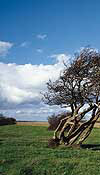Selecting a Wind Turbine Site
![]()

© 1997 Soren Krohn

![]() Wind
Conditions
Wind
Conditions
Looking at nature itself is usually an excellent guide to finding a suitable
wind turbine site.
![]() If there are trees and shrubs in the area, you may get a good clue about
the prevailing wind direction, as you do in the
picture to the left.
If there are trees and shrubs in the area, you may get a good clue about
the prevailing wind direction, as you do in the
picture to the left.
![]() If you move along a rugged coastline, you may also notice that centuries
of erosion have worked in one particular direction.
If you move along a rugged coastline, you may also notice that centuries
of erosion have worked in one particular direction.
![]() Meteorology data, ideally in terms of a wind rose
calculated over 30 years is probably your best guide, but these data are
rarely collected directly at your site, and here are many reasons to be
careful about the use of meteorology data, as we explain in the next section.
Meteorology data, ideally in terms of a wind rose
calculated over 30 years is probably your best guide, but these data are
rarely collected directly at your site, and here are many reasons to be
careful about the use of meteorology data, as we explain in the next section.
![]() If there are already wind turbines in the area, their production results
are an excellent guide to local wind conditions. In countries like Denmark
and Germany where you often find a large number of turbines scattered around
the countryside, manufacturers can offer guaranteed production results on
the basis of wind calculations made on the site.
If there are already wind turbines in the area, their production results
are an excellent guide to local wind conditions. In countries like Denmark
and Germany where you often find a large number of turbines scattered around
the countryside, manufacturers can offer guaranteed production results on
the basis of wind calculations made on the site.
Look
for a view
As you have learned from the previous pages, we would like to have as wide
and open a view as possible in the prevailing wind direction, and we would
like to have as few obstacles and as low a roughness
as possible in that same direction. If you can find a rounded hill to place
the turbines, you may even get a speed up effect
in the bargain.
Grid
Connection
Obviously, large wind turbines have to be connected to the electrical
grid.
![]() For smaller projects, it is therefore essential to be reasonably close
to a 10-30 kilovolt power line if the costs of extending the electrical
grid are not to be prohibitively high. (It matters a lot who has to pay
for the power line extension, of course).
For smaller projects, it is therefore essential to be reasonably close
to a 10-30 kilovolt power line if the costs of extending the electrical
grid are not to be prohibitively high. (It matters a lot who has to pay
for the power line extension, of course).
![]() The generators in large, modern wind turbines generally produce electricity
at 690 volts. A transformer located next to the turbine, or inside the turbine
tower, converts the electricity to high voltage (usually 10-30 kilovolts).
The generators in large, modern wind turbines generally produce electricity
at 690 volts. A transformer located next to the turbine, or inside the turbine
tower, converts the electricity to high voltage (usually 10-30 kilovolts).
Grid
Reinforcement
The electrical grid near the wind turbine(s) should be able to receive
the electricity coming from the turbine. If there are already many turbines
connected to the grid, the grid may need reinforcement, i.e. a larger
cable, perhaps connected closer to a higher voltage transformer station.
Read the section on Electrical Grid Issues
for further information.
Soil
Conditions
Both the feasibility of building foundations of the turbines, and road
construction to reach the site with heavy trucks must be taken into account
with any wind turbine project.
Pitfalls
in Using Meteorology Data
Meteorologists already collect wind data for weather forecasts and aviation,
and that information is often used to assess the general wind conditions
for wind energy in an area.
![]() Precision measurement of wind speeds, and thus wind energy is not nearly
as important for weather forecasting as it is for wind energy planning,
however.
Precision measurement of wind speeds, and thus wind energy is not nearly
as important for weather forecasting as it is for wind energy planning,
however.
![]() Wind speeds are heavily influenced by the surface roughness of the surrounding
area, of nearby obstacles (such as trees, lighthouses or other buildings),
and by the contours of the local terrain.
Wind speeds are heavily influenced by the surface roughness of the surrounding
area, of nearby obstacles (such as trees, lighthouses or other buildings),
and by the contours of the local terrain.
![]() Unless you make calculations which compensate for the local conditions
under which the meteorology measurements were made, it is difficult to estimate
wind conditions at a nearby site. In most cases using meteorology data directly
will underestimate the true wind energy potential in an area.
Unless you make calculations which compensate for the local conditions
under which the meteorology measurements were made, it is difficult to estimate
wind conditions at a nearby site. In most cases using meteorology data directly
will underestimate the true wind energy potential in an area.
![]() We'll return to how the professionals do their wind speed calculations
on the following pages.
We'll return to how the professionals do their wind speed calculations
on the following pages.
![]()
|
Back | Home | Forward |
© Copyright 1998 Soren Krohn. All rights reserved.
Updated 6 August 2000
http://www.windpower.org/tour/wres/siting.htm